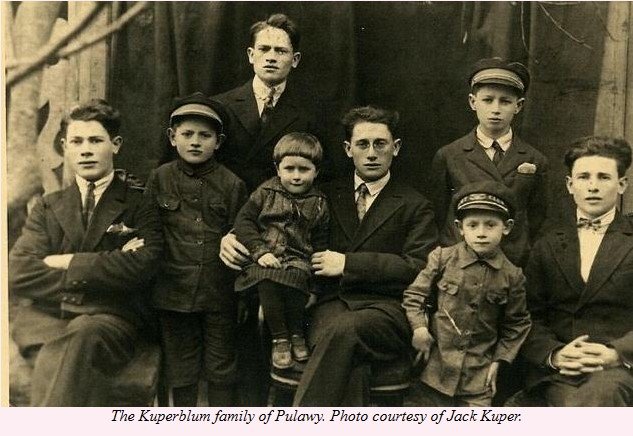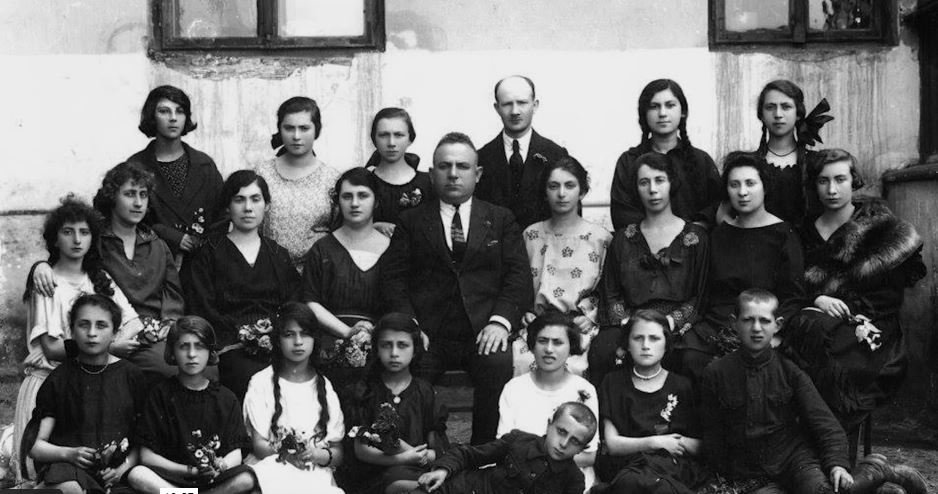Remember Jewish Pulawy
Pronunciation: Poo-lav-ee
HISTORY OF JEWISH PULAWY
Pulawy is 30 miles north and west of Lublin, the largest city in eastern Poland. Around 3,600 Jews lived in Pulawy out of an overall population of approximately 12,000 in 1939. Pulawy was the administrative center in the Lublin District, and it included villages and the farms nearby: Baranow (1,100 Jews in 1939), Bobrowniki (200 Jews), Deblin-Irena (3,500 Jews in 1939), Janowiec (~360 Jews), Jozefow Nad Wisla (1,000 Jews), Kurow (2,000 Jews), Kazimierz (2,500 Jews), Konskowola (750-1,200 Jews), Markuszow (2,000 Jews), Michow (1,700-2,000 Jews), Naleczow (250-400 Jews), Opole Lubelski (7,000 Jews), Ryki (3,000-4,000 Jews), Stezyca (125 Jews) and Wawolnica (1,000-1,200 Jews). There may have been Jews in nearby villages such as Karczmiska,
Poniatowa, Szumow, Wola Czolnowska, Zagozdz and Zyrzyn, but that information is not known.
There was an organized Jewish community in Pulawy from 1820. In 1897 it numbered 3,883 (about 73% of the population). The principal Jewish occupations were shoemaking, gardening, furniture-making and shop-keeping. From the middle of the 19th century, the influence of Chasidism became widespread among the Jews of Pulawy. From 1875 to 1884 the rabbinical seat of Pulawy was held by Elijah Lerman, the author of Devar Eliyahu (1884). In 1888, Chaim Israel Morgenstern, the grandson of Menachem Mendel of Kotsk, founded a Hasidic court in Pulawy. In 1910 there were 6,111 Jews (61% of the population). During World War I, the Jewish population of the town decreased due to persecutions and a fire. From 1917, branches of all parties then active on the Jewish scene were organized in Pulawy. At first, the Bund and Agudat Israel wielded the greatest influence, but Po'alei Zion circles, other Zionist parties, and Communists also became popular. In 1921 there were 3,221 Jews (45% of the population) living in the town. Between the two world wars, there was a private Hebrew secondary school, as well as Tarbut, Yavneh and Beth Jacob schools, and a Jewish library.
Members of the organization Linas Hatzedek in Pulawy in 1925 included: Abram Mandelbaum, merchant (son of Menasha); Henoch Rechelz (son of Lejb), industrialist; Moshe Najmark (son of Chaim); Berek Nisenbaum (son of Boruch), merchant; Moshe Holcman (son of Abush), merchant; Judka Goldberg (son of Abram Icek); Majer Mandelbaum (son of Yermiyahu); Moshe Goldszlager (son of Szmuel); and Jankiel Roter (son of Chil). Employees of Pulawy Jewish community in 1930 included: M. Naj, rabbi; shochets M. Kitner, P. Szechtman and J. Tenenbaum; treasurer Sz. Melman; religious educator N. Waserman; secretary M. Rubinsztajn; head of the Talmud Torah school Ch. M. Szwarcenberg; watchman W. Szabason; synagogue sextons Ch. Bronsztajn, H. Goldnudel and Sz. Brik; grave digger Sz. Altman; writer M. Zysman; and D. Perelman, whose city position is not clear.
THE HOLOCAUST IN PULAWY
A Wehrmacht unit occupied Pulawy in mid-September 1939 and the Jewish population was immediately confronted with violence and their possessions confiscated. Henryk Adler, the chairman of the kehilah and a public school director, was named head of the Jewish Council (Judenrat). Other council members included Dr Benjamin Honigsfeld, Kleinbaum Edelstein, and Moshe Rubinstein.
By the end of October 1939, the German administration ordered the Jews to move to a specially designated quarter, located in a pre-war district inhabited mostly by impoverished Jews. The ghetto spanned an area which was about one fifth of the total size of Pulawy. Its streets included Piaskowa, Polna, Gdansk, Niemcewicz, and two courtyards. The Jews were confined to Gdansk and Piaskowa Streets.
The war damage in Pulawy may have been one of the factors for the early establishment of the ghetto, the first in Lublin District, and indeed among the earliest ghettos created in the General Gouvernement. In early November 1939, the Germans put up posters in Pulawy instructing the Jews to move into the ghetto. One Holocaust survivor recalled that that the Germans issued an order on November 4, 1939, expropriating all Jewish-owned businesses hours before the Jews had to move into the ghetto. Conditions in the ghetto were poor, there was no sewage system, nor electricity, as the German bombardment had destroyed the power plant in the first few weeks of the war. The area designated for the ghetto was far too small for its 4,000 inhabitants. The Germans seized on the opportunity and organized night-time raids on the ghetto to plunder Jewish homes, in search of valuables and jewelry. Brutal beatings were commonplace and those who violated the 5pm curfew were shot on the spot. The Jewish population was reduced every day, as many young people fled to nearby villages, as Jews were permitted at this early point to leave the ghetto for two hours daily.
The ghetto in Pulawy was short lived; it was the first ghetto to be liquidated in the Lublin district. Posters were put up by the Germans on December 26, 1939, giving the Jews 48 hours to pack their belongings in preparation for resettlement. Because the temperatures hovered below freezing, the Jewish Council offered the local German authorities a bribe to postpone the evacuation action until the spring. This was rejected as was a similar appeal from a group of Jewish women with young children.
The Jews did not enjoy the promised 48 hours, as the Germans started the aktion on the night of December 27, 1939, German police units (probably from nearby Kazimierz Dolny) stormed the ghetto. They searched Jewish homes with their dogs, ordered men from their beds onto the streets, and ordered women to pack up belongings. This expulsion was accompanied by savage beatings and screaming. The German police units ordered the men to stand in a row on Lublin Street, the main street in Pulawy, facing the buildings with their arms raised, and to sing in the freezing cold till morning. Because they had been dragged from their beds, many were dressed only in nightclothes. The Germans guarding them beat them savagely, while SS men standing nearby photographed the beatings. The German police locked the infirm and physically handicapped Jews in the unheated synagogue where they all almost froze to death.
The resettlement took place the next morning -- at 8am the men held captive along Lublin Street were marched all together to Opole Lubelski. Along the way some of the German guards brutally beat them. The women were given until noon to vacate Pulawy. Most were forced to walk the 20 miles to Opole with their luggage, as only a few managed to hire wagons. Many infants died from exposure along the road. Some 2,500 Jews arrived in Opole. However, some of the Jews of Pulawy decided to flee to nearby towns and villages, such as Wawolnica, Kazimierz Dolny, and Belzyce.
After German Police units surrounded Kazimierz Dolny early on December 29, 1939, looking to drive out unregistered Jews from the town, most of the refugees from Pulawy were forced to flee from the town across the frozen fields to Belzyce. After the expulsions, the only Jews officially permitted to live in Pulawy were were about 500 Jewish prisoners who were incarcerated in four Judenlager, for forced laborers. The inmates cleaned streets, repaired railway tracks, worked on road construction, and hauled timber at the state-owned sawmill.
On May 15, 1942, 261 Jews from Bardejov, Slovakia were deported to Pulawy. On May 16, 1942, an additional 140 Jews from Slovakia were deported to Opole Lubelski Ghetto. On May 17, 1942, 1,110 Jews from Bardejov, Slovakia were sent to Naleczow Labor Camp. And on May 24, 1942, a transport of several hundred Jews was sent to the Rejowiec Ghetto.
In the summer of 1943, SS- Oberscharfuhrer Otto Hantke, who had been in charge of the Jewish forced labor camp in Budzyn until the beginning of December 1942 and afterward in charge of the Jewish forced labor camp in Poniatowa was sent to Pulawy in order to establish the sawmill as a sub-camp of the Lublin concentration camp. Some 486 Jewish were employed in this sub-camp. Although, the sawmill operated at a profit, thanks to the exploitation of the workers, the Jewish prisoners there were murdered on November 3, 1943, as part of Aktion Erntefest.
Please review the site content below. Zachor - We Remember.
------------------------------------------------------------------------
[Virtual Sztetl: History of Pulawy]
[List of Contributors — Jewish community in Pulawy]
[List of Jewish Taxpayers in Pulawy, 1929]
------------------------------------------------------------------------
Note: Also in the photo are: back row, Kisel Szajdenfisz; to his left (blonde hair) is Ben Roiter.
Students at the public school in Pulawy, pre-war; Adler was the teacher.
Students at the public school in Pulawy, pre-war; Adler was the teacher.
LINKS
Town of Pulawy:
- Book: Child of the Holocaust by Jack Kuper
- Book: Hell in Sobibor: The Tragedy of a Jewish Teenager by Stanislaw Szmajzner
- Gorodecki Family Photos: Pulawy
Majdan Tatarski Ghetto Victims (Lublin) from Pulawy:
Boruch Blumenkranc
Jakub Blumenkranc
Mordko Blumenkranc
Chaim Bryfman
Rywka Cukierman
Majer Edelsztajn
Frymeta Edelsztajn
Szymon Edelsztajn
Dawid Englender
Lejzor Epsztejn
Majer Erlich
Dawid Franenberg
Abram Gorzyczanski
Biniamin Kierszenbaum
Jankiel Klajnbaum
Mendel Kuperblum
Chaim David Langfus
Jechiel Michael Lewin
Chaim Szol Lewin
Tama Rajzla Lewin
Dr. Moszek Lewin
Szlama Madrowski
Menasze Norman
Abram Rapaport
Froim Fiszel Rozenbaum
Nachman Juda Rozenblat
Frajdla Rubinsztajn
Lejba Rubinsztajn
Bencian Szabaszon (Szabszon)
Ela Szerman
Gecel Szerman
Laja Blima Urman
Srul Nuta Wajcman
Fajga Wajnberg
Zysla Wajnberg
Majlech Winograd
Samuel Weinberg
Hersz Dawid Zajdentreger
Jankiel Zalc
Sara Zygielwaks
(source: Brama Grodzka - Teatr NN)
Survivors of Pulawy:
- David Englender (went to Canada)
- Malka Perelman Friedman
- Gimple Greenberg
- G...(?) Goffeld (went to Israel)
- Chawa Tartszic Korman
- Moshe Kleinberg
- Morris Korenberg (went to France)
- Jankel Kuperblum (Jack Kuper)
- Celia Landman Rojzman
- Mendel Rosenzweig
- Avraham Shniterman (went to Israel)
- Serka Kerszenblat Wilner
Notable People:
- Simja/Simcha Sneh, Argentine Yiddish poet and author
- Shlomo Szmajzner, survivor of Sobibor
Rabbis of Pulawy:
- Eliyohu Ben Avrum Lerman, 19th century
- Froim Taub
- Nachum Wajdrich
- Alter Azriel Meir ben Avraham Ejger (Eiger)
- Avigdor Menachem Mendel Nie (Naj)
Righteous Gentiles:
- Jan Machul, farmer living at Cezaryn, was shot on July 3, 1943 with 2 Jews he was sheltering.
Genealogy:
- Jewish Records Indexing Poland - Pulawy
- Jewish Vital Records in the Polish State Archives
Remember Your Family:
- Central Judaica Database - Museum of History of Polish Jews
- Grandchildren of Holocaust Survivors on Facebook
- Guide to the YIVO Archives
- Holocaust News/Events from Generations of the Shoah Int'l
- Holocaust Survivors and Victims Database
- JewishGen Family Finder
- JewishGen Holocaust Database
- JRI-Poland: Search for Your Family
- Museum of History of Polish Jews Introduction
- Yad Vashem: Search for Your Family
- Yad Vashem: Submit Names of Your Family Members
- Yad Vashem Requests Photos of Shoah Survivors and Families
CONTACTS
U.S.: LublinJewish@gmail.com















